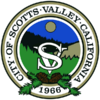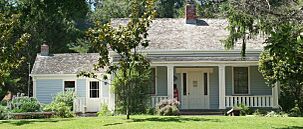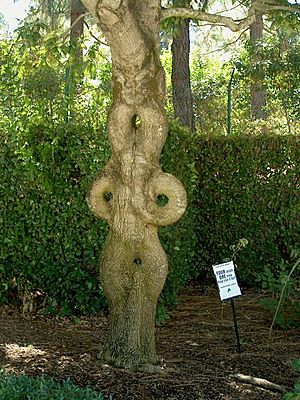Scotts Valley, California facts for kids
Quick facts for kids
City of Scotts Valley
|
|||
|---|---|---|---|
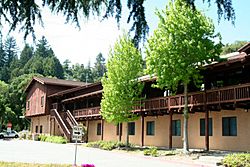
Back view of the Scotts Valley Civic Center/City Hall and Police Department
|
|||
|
|||
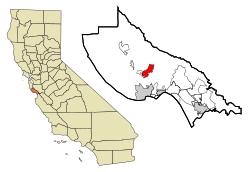
Location in Santa Cruz County and the state of California
|
|||
| Country | United States | ||
| State | California | ||
| County | Santa Cruz | ||
| Incorporated | August 2, 1966 | ||
| Area | |||
| • Total | 4.62 sq mi (11.96 km2) | ||
| • Land | 4.62 sq mi (11.96 km2) | ||
| • Water | 0.00 sq mi (0.00 km2) 0% | ||
| Elevation | 561 ft (171 m) | ||
| Population
(2020)
|
|||
| • Total | 12,224 | ||
| • Density | 2,663.18/sq mi (1,028.70/km2) | ||
| Time zone | UTC−8 (PST) | ||
| • Summer (DST) | UTC−7 (PDT) | ||
| ZIP codes |
95060, 95066, 95067
|
||
| Area code(s) | 831 | ||
| FIPS code | 06-70588 | ||
| GNIS feature ID | 0277598 | ||
Scotts Valley is a small city in Santa Cruz County, California. It is located about 30 miles (48 km) south of San Jose. The city of Santa Cruz is only 6 miles (9.7 km) north. Scotts Valley sits in the hills of the Santa Cruz Mountains.
About 12,224 people lived here in 2020. The main way to get to the city is by State Route 17. This highway connects Scotts Valley to San Jose and Santa Cruz. Scotts Valley became an official city in 1966.
Contents
History of Scotts Valley
Ancient Times and Early Settlers
Long ago, about 10,000 years ago, there was a lake in the lowest part of Scotts Valley. Scientists found proof that people lived here between 9,000 and 12,000 years ago. The lake slowly dried up, forming Carbonera Creek. People then moved closer to the creek.
Around 2000 BC, the Ohlone people lived along the creeks and springs. They built villages on higher ground to avoid floods. They hunted and gathered food like seeds, acorns, and grasses. Today, areas near these waterways are important for finding old cultural sites.
How Scotts Valley Got Its Name
Scotts Valley is named after Hiram Daniel Scott. He bought the land, called Rancho San Agustin, in 1850. Before him, the land belonged to Joseph Ladd Majors.
The first European to live here was José Bolcoff. He was born Osip Volkov in Siberia around 1794. He came to California as a fur trader. In 1815, he left his ship and quickly became part of the Spanish culture. He changed his name to José Antonio Bolcoff. He even worked as an interpreter for California's governor.
In 1833, Bolcoff became a Mexican citizen. He built a home on his 4,400-acre (18 km²) land grant. This home was likely near where the Kings Village Shopping Center is today. Later, Bolcoff sold his land to Joseph Ladd Majors for $400. In 1846, the area became part of the United States.
The Historic Scott House
Hiram Scott built the Scott House in 1853. It is built in the Greek Revival style. This house is now a Santa Cruz County Historical Trust Landmark. It is also listed on the National Register of Historic Places. You can find it behind the City Hall today.
Early Industries and Changes
From the 1840s, Scotts Valley made money from several things. These included cutting down trees (lumber) and grinding grain. A very important industry was tanning animal hides and making leather.
Later, in the 1930s, people dug up peat moss from Scotts Valley. This moss was sent to San Francisco for growing special plants. After the peat ran out, sand and gravel were dug up and sold.
Famous Residents and Companies
The famous film director Alfred Hitchcock lived in Scotts Valley from 1940 to 1972. His home was on a mountaintop estate. Florence Owens Thompson, known from the "Migrant Mother" photograph, also passed away in Scotts Valley in 1983.
Netflix was started in Scotts Valley in 1997 by Reed Hastings and Marc Randolph.
Economy and Tourism
A Place for Travelers
Scotts Valley has always been a place that helps travelers. In the early 1900s, when cars became popular, tourism grew.
In the 1920s, Camp Evers opened. It had a store, gas pumps, a dance hall, and tents. It was a popular place for travelers to stop and rest.
Fun Attractions of the Past
In the 1930s, Beverly Gardens opened. It had many different birds and animals, a restaurant, and cabins.
Axel Erlandson opened The Tree Circus in 1947. He grew and shaped trees into amazing and unusual forms. In 1964, the Tree Circus became "The Lost World." It added large, colorful dinosaur statues. Today, some of these special trees are at Gilroy Gardens.
Santa's Village was a popular Christmas-themed park. It opened in 1957 and attracted many visitors for over 20 years. It was one of the first theme parks in America. The park had Santa, Mrs. Santa, elves, and gnomes. There were rides, a petting zoo, and a gingerbread bakery. Santa's Village closed in 1979. The land is now a playing field at the former headquarters of Borland.
Scotts Valley is also close to beautiful nature parks. These include Big Basin Redwoods State Park and Henry Cowell Redwoods State Park. The town is surrounded by tall coast redwood trees.
The city has a large municipal skateboard park. It is near Skypark, which used to be an airport.
Modern Businesses and Technology
Many technology companies have been based in Scotts Valley. E-mu Systems, Seagate Technology, Sessions, and Borland Software Corporation all had their main offices here.
Zero Motorcycles makes electric motorcycles in Scotts Valley.
Netflix started its first headquarters in Scotts Valley in 1997. Later, it moved to Los Gatos, California.
In 2016, the University of California, Santa Cruz opened its Scotts Valley Center. This center houses offices for their Information Technology, Business, and University Relations departments.
Major Employers in Scotts Valley
Here are some of the biggest employers in Scotts Valley:
| # | Employer | # of Employees |
|---|---|---|
| 1 | Threshold Enterprises | 347 |
| 2 | Central California Alliance for Health | 309 |
| 3 | Bay Photo Lab | 279 |
| 4 | Zero Motorcycles | 227 |
| 5 | Fox Factory | 165 |
| 6 | 1440 Multiversity | 115 |
| 7 | Bell Sports, Inc | 104 |
| 8 | Permanente Medical Group | 95 |
| 9 | The Camp | 91 |
| 10 | Digital Dynamics | 76 |
Population and People
| Historical population | |||
|---|---|---|---|
| Census | Pop. | %± | |
| 1970 | 3,621 | — | |
| 1980 | 6,891 | 90.3% | |
| 1990 | 8,615 | 25.0% | |
| 2000 | 11,385 | 32.2% | |
| 2010 | 11,580 | 1.7% | |
| 2020 | 12,224 | 5.6% | |
| U.S. Decennial Census | |||
Who Lives in Scotts Valley?
In 2010, Scotts Valley had 11,580 people. Most people (86%) were White. About 5.1% were Asian, and 2.5% were from other races. About 10% of the population was Hispanic or Latino.
Most people (97.7%) lived in homes. There were 4,426 households. About 35.9% of these homes had children under 18. Many homes (54.7%) were married couples living together.
The average household had 2.55 people. The average family had 3.03 people.
Age Groups in the City
The population was spread out by age:
- 24.7% were under 18 years old.
- 8.4% were 18 to 24 years old.
- 21.7% were 25 to 44 years old.
- 31.6% were 45 to 64 years old.
- 13.6% were 65 years or older.
The average age in Scotts Valley was 41.7 years. For every 100 females, there were about 95.1 males.
Education in Scotts Valley
The Scotts Valley Unified School District runs four public schools:
- Scotts Valley High School (grades 9-12)
- Scotts Valley Middle School (grades 6-8)
- Vine Hill School (grades Kindergarten-5)
- Brook Knoll School (grades Kindergarten-5)
These schools serve over 2,600 students each year. The district also has a program for students who learn at home.
Baymonte Christian School is a private school. It teaches students from pre-Kindergarten to eighth grade. It was founded in 1968. In 2003, it won a "Blue Ribbon School" award. This award is given to only a few schools across the country.
Monterey Coast Preparatory School is another private school. It helps middle and high school students who learn differently. It moved to Scotts Valley in 2014.
Past Entertainment Spots
The Barn Concert Venue
From 1965 to 1968, a place called The Barn was popular. It was an art gallery and coffee house. It also had a big area for concerts. Famous musicians like Janis Joplin and the Grateful Dead performed there. The Barn closed as a nightclub in 1968. The building was torn down in 1991.
Santa's Village Amusement Park
Santa's Village (Scotts Valley) was an amusement park that operated from 1957 to 1979. It was one of the first Santa's Village parks in the United States. It was located near Highway 17. The company Borland later built its campus on this site.
Geography and Climate
Where is Scotts Valley Located?
Scotts Valley is in the western hills of the Santa Cruz Mountains. State Route 17 connects it to Santa Cruz in the south. It also connects to Los Gatos and San Jose to the north.
The city is part of the WWF-named Northern California coastal forests area. This means it has a special type of forest.
Scotts Valley covers about 4.6 square miles (11.9 km²). All of this area is land.
Weather in Scotts Valley
The air in Scotts Valley comes from the Pacific Ocean. This means the weather is often mild. Summers are warm and dry. Winters are mild and usually rainy. Most of the rain falls between November and April.
Scotts Valley has a Mediterranean climate. This means it has cool, wet winters and warm, mostly dry summers. Because it is close to Monterey Bay, fog and low clouds are common in the mornings, especially in summer.
| Climate data for Scotts Valley, California (1981–2010 normals) | |||||||||||||
|---|---|---|---|---|---|---|---|---|---|---|---|---|---|
| Month | Jan | Feb | Mar | Apr | May | Jun | Jul | Aug | Sep | Oct | Nov | Dec | Year |
| Mean daily maximum °F (°C) | 60.6 (15.9) |
62.3 (16.8) |
64.4 (18.0) |
67.5 (19.7) |
70.1 (21.2) |
72.9 (22.7) |
73.4 (23.0) |
74.3 (23.5) |
74.5 (23.6) |
71.5 (21.9) |
64.9 (18.3) |
60.0 (15.6) |
68.0 (20.0) |
| Mean daily minimum °F (°C) | 40.8 (4.9) |
42.7 (5.9) |
44.0 (6.7) |
45.5 (7.5) |
48.6 (9.2) |
51.5 (10.8) |
53.7 (12.1) |
53.9 (12.2) |
52.6 (11.4) |
49.0 (9.4) |
44.3 (6.8) |
40.8 (4.9) |
47.3 (8.5) |
| Average precipitation inches (mm) | 6.40 (163) |
6.24 (158) |
4.67 (119) |
1.99 (51) |
0.85 (22) |
0.19 (4.8) |
0.01 (0.25) |
0.04 (1.0) |
0.27 (6.9) |
1.44 (37) |
3.75 (95) |
5.68 (144) |
31.53 (801) |
| Average precipitation days (≥ 0.01 in) | 10.6 | 10.9 | 10.0 | 5.9 | 3.3 | 1.3 | 0.3 | 0.7 | 1.5 | 3.5 | 7.5 | 10.7 | 66.2 |
| Source: NOAA | |||||||||||||
City Services
Water and Wastewater
The Scotts Valley Water District provides drinking water to the city. All the water comes from underground sources using wells.
Wastewater is treated at the Scotts Valley Wastewater Treatment Plant. After treatment, the cleaned water is sent into the Pacific Ocean.
Transportation
Bus service is available from Scotts Valley to Santa Cruz, the San Lorenzo Valley, and San Jose. This service is provided by the Santa Cruz Metropolitan Transit District.
The Santa Cruz Sky Park, a small airport for fun flights, closed in 1983.
Sister City
Scotts Valley has a sister city:
See also
 In Spanish: Scotts Valley para niños
In Spanish: Scotts Valley para niños



